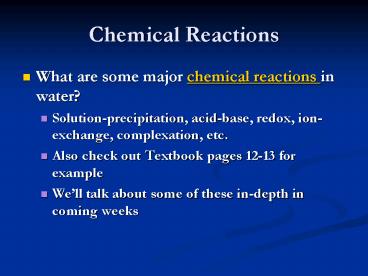Chemical Reactions - PowerPoint PPT Presentation
1 / 11
Title: Chemical Reactions
1
Chemical Reactions
- What are some major chemical reactions in water?
- Solution-precipitation, acid-base, redox,
ion-exchange, complexation, etc. - Also check out Textbook pages 12-13 for example
- Well talk about some of these in-depth in coming
weeks
2
Dissolved Gases, Alkalinity-Acidity Hardness
- Why and how gases dissolve in water?
- Henrys law Ci KiPi
- Role dissolve gases (DO) play in water chemistry
- Oxygen Org CO2 water (BOD and/COD)
- Oxygen dissolved iron water rust acidity
- CO2 dissolves easily (K 3.3810-2) gt increase
in H (pH5.7) help dissolve carbonate
subsurface (soil) gt CaCO3H Ca HCO3
3
Acidity vs. Alkalinity
- Acid (donate H) vs. base (accept H)
- Difference between pH and acidity
- pH -log (H) gt (H) 10-pH
- Acidity amount of base needed to change pH to
endpoint - Why acidity important?
- Sources and types of acidity
- Mineral acidity vs. gas acidity
- how to determine and/or calculate acidity
4
Net Acidity and Net Alkalinity
- Sources of alkalinity and types of alkalinity
- How to determine alkalinity
- How to convert Alk. in CaCO3 mg/L to HCO3-
- HCO3 Alk61/1(210-10.3/10-pH)50
- Net acidity hot acidity gt Calculated acidity
Alkalinity -Net alkalinity - Net alkalinity alkalinity - acidity
5
Hardness in Water
- Caused by Ca and Mg containing minerals and
other divalent cations (Fe, Mn, etc.) - Causes problems scales, less suds, soap scum
- Ca 2HCO3 -gtCaCO3 H2O CO2
- Measured as CaCO3 (mg/L) or grains 17 ppm/grain
- gt5 grains per gallon (gt100 ppm) need treatment
(softener) - Softener are based on Ion Exchange (Ca w/ Na)
- People w/ high pressure should ne cautious about
Na - Hardness measured by titration using blue
indicator EDTA - Total hardness as CaCO3 Ca hardness Mg
hardness - Ca and Mg (mg/L) can be calculated from hardness
data - Ca Hardness 0.4 Ca ppm
- Mg Hard 0.84gtMgCO3.29 Mg ppm
6
Ion Exchange and Complexation Reactions
- Cations/Anion with similar charge/radii can be
exchanged between solution and exch. surface - Water softener exchanges Na for Ca and Mg
- Important process in soil water solution for
plants - Complexation are charged compounds
- Important for polyvalent ions (Cr, Fe, Al, Pb,
As..) - Provide a means for trace metal transport
- PHREEQC can calculate easily (manual calc. hard)
7
Soil Erosion We Cant Afford It
- While the farmer holds title to the land, it
belongs to all of the people because civilization
itself rests upon soil. - Thomas Jefferson
- When the soil is gone, men must go and the
process does not take long. - Theodore Roosevelt
- Soil is a few inches between humanity and
starvation. (source unknown) - Like Geology or Biology, Soil Science is a
discipline
8
Soil Irrigation Water Chemistry
- Definition and Importance
- Crop, removal of bio-chem. contaminant, nutrient
recycling, building materials, waste disposal,
eng. etc. - Composition minerals clay, nutrients,
organisms, organics (humus), water, and gases
(air) - Soil Formation Factors ClORPT
- Soil Classification Sand-Silt-Clay ratio
(Ternary) - Nutrients macro (NPKS, Ca, Mg), micro (Fe, Mn,
Zn, Cu, Co), and trace (Pb, Cd, Hg, B, Ce)
9
Soil Chemistry (contd)
- Processes Solution-Precip
- Adsorption-Desorption (AlgtHgtCagtMggtKgtNa)
- Cation Exchange (humusgtvermiculitegtsmectititegtilli
tegtchloritegtkaolinitegtFe, Al oxides), - Complexation (for poly-valent cations),
- Chealation (FegtCu, ZngtMg,),
- Plant Uptake, Transportation/Mobility
- Factors pH and acidity (active vs. reserve),
Eh, CEC and B.S., Humus, Clay (dep. on types)
10
Soil Chemistry (contd)
- Determination of lime requirements (for acidic
soil), - Gypsum (for sodic soil), nutrients (K, N, P),
organic content (LOI) for CEC adsorption. - Factors Effecting Soil Erosion (R)USLE
- A (tons/hec)RKLSCP (explain terms)
- EI (RKLS)/T Ttolerance in Mg/Hec (used in
USDAs CCP) - T 4-11 Million grams/hec Egt8 is a problem
- Sources of Soil Contamination and Soil
Remediation - LUST, pesticides, trace/heavy metals, cleaning
agents - Excavation disposal to landfill, soil venting,
bio/phytoremediation, onsite treatment (venting,
bioenhanced farming, thermal treatment)
11
Irrigation Water
- Salinity (EC in mmohs/cm) Plant sensitivity to
salt, gt3 is high risk - SAR Na/sq.rt.CaMg/2 in meq/L
- gt18 high risk
- RSC(CO3HCO3)-(CaMg) in meq/L
- gt2.5 high risk
- Toxic elements good in moderation, but bad in
excess - B ( helps cell division),
- Na (damages soil structure CEC),
- Co, Ni, As, Zn
- Cu (helps metabolism)
- Mn (imp. for photosysn.)
- Mo (helps w/ N assimilation)
- Zn (promotes hormone growth) for irrigation
water.































